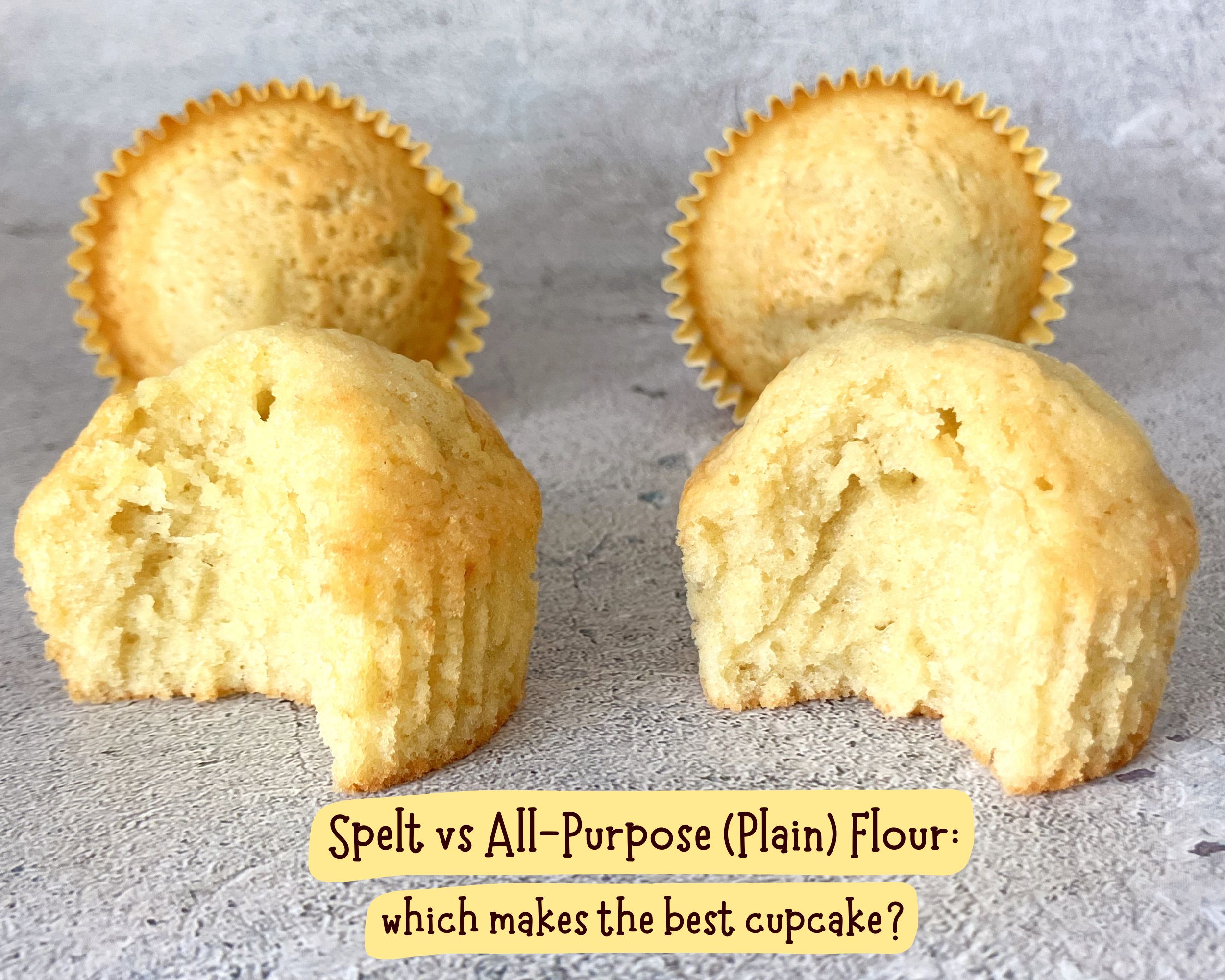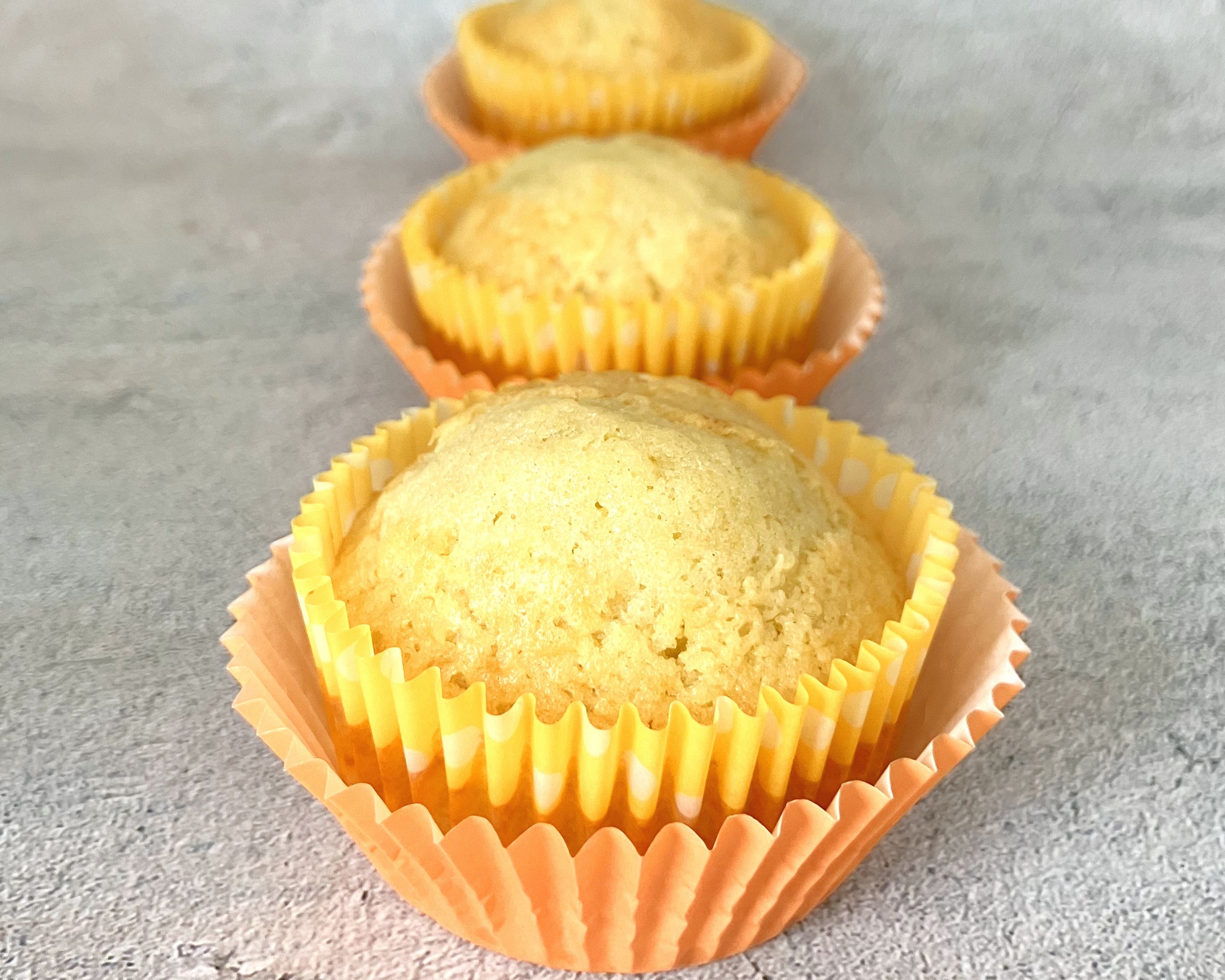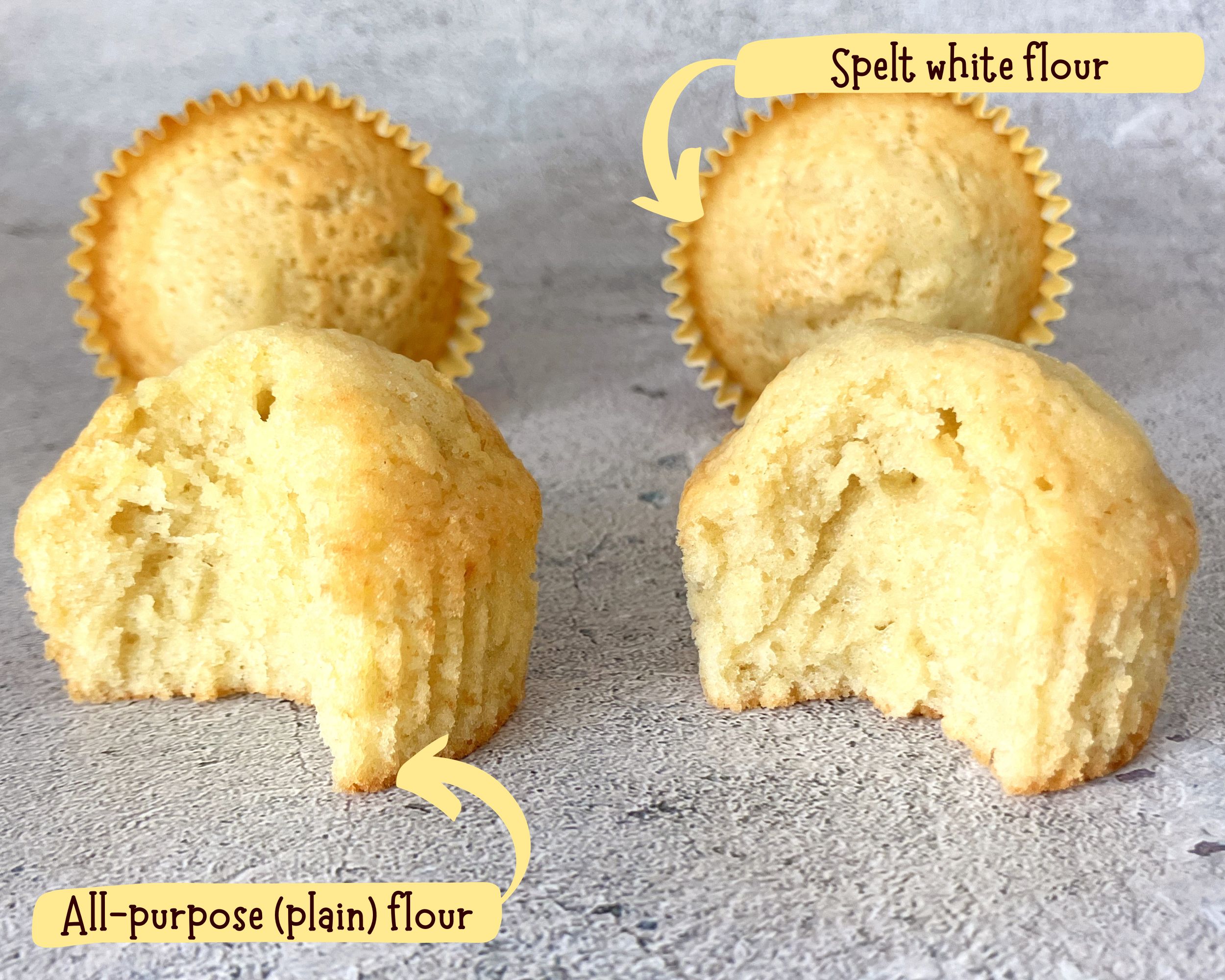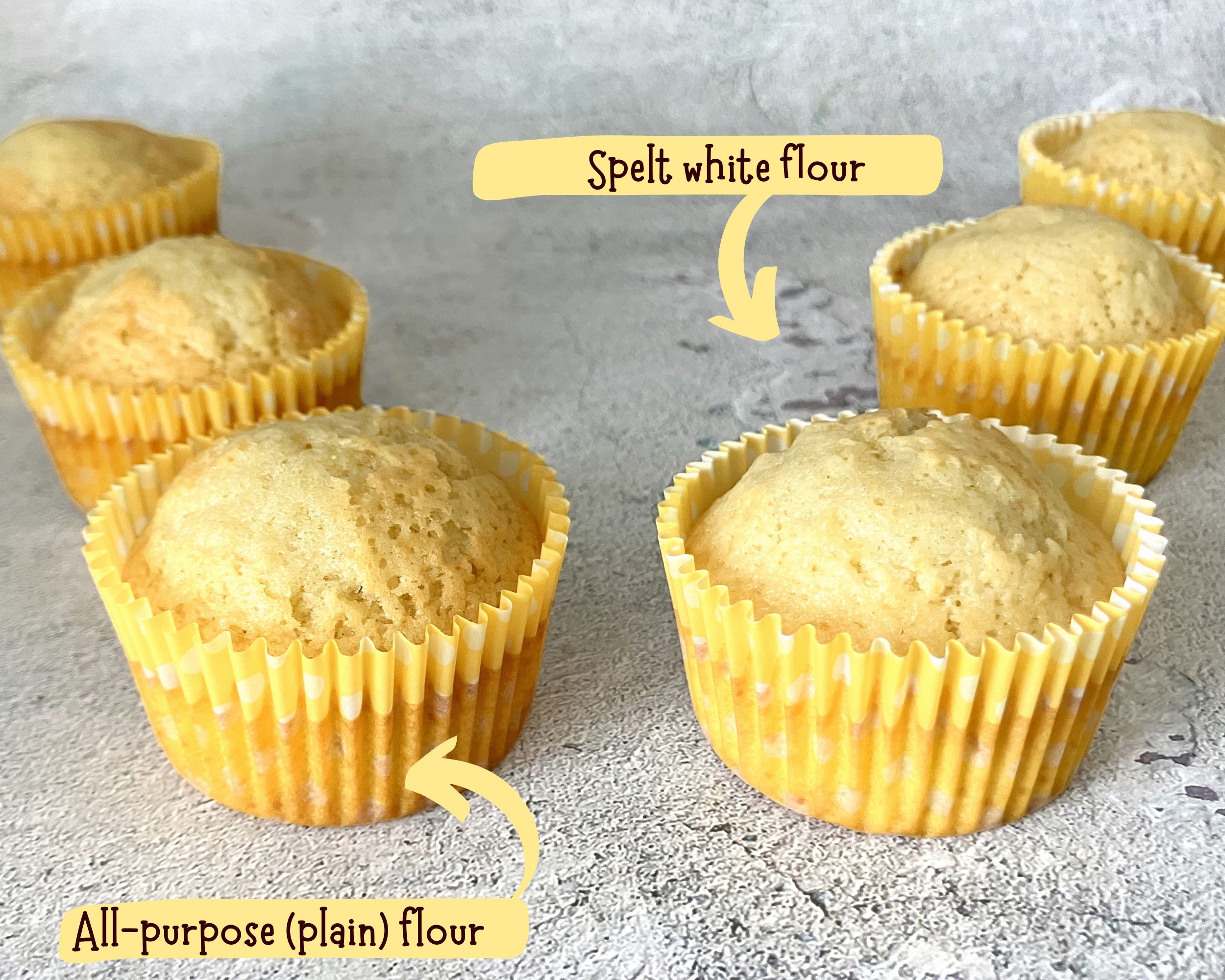Spelt vs Plain Flour: Which Makes the Best Cupcake?
Spelt vs plain flour: which makes the best cupcake? Well, we’re about to find out. This post is a comparison of how spelt flour and plain (all-purpose) flour work in the same recipe. Spelt often gets a bad rap as being dense or harder to work with, and I am here to put the record straight.
I have baked two batches of cupcakes, one with spelt flour, the other with all-purpose flour. Are you ready to find out which flour comes out on top?
If you’re new to spelt flour and still finding your feet, check out my tutorial: A Beginner’s Guide to Spelt Flour.

I’m in the Amazon Associates program, and some of the links in this post are affiliate links. Please read my disclosure and privacy policy for more information.
_________
What is the difference between all-purpose and plain flour?
Before we go any further, perhaps I need to just mention the different terminology I use for flours. Most of my readers come from the US and UK, so I take care to ensure that both understand what I am talking about. My third highest following comes from Australia, and thankfully, our Aussie friends are very similar to the UK when it comes to baking terminology.
In the UK (and Australia), we call regular white flour plain. In the US, it is referred to as all-purpose. I use both terms interchangeably. When we add baking powder to the flour, it is called self-raising in the UK, and self-rising in the US. Thankfully, spelt is just spelt wherever you are. Unless you’re in Sweden, then we call it dinkel.
And while we are on the subject, the terms wholegrain (US) and wholemeal (UK) are referring to the same thing.
Why compare cupcakes made with spelt flour and all-purpose flour?
The difference between spelt and plain flour is not something I’ve really thought about. Yes, I have talked long and hard about spelt flour can be used interchangeably with all-purpose flour, but I’ve never baked the same recipe, at the same time, to get a comparison.
A few years ago, I stopped buying plain flour, and I am a resounding advocate of spelt. Although I do not have any serious conditions, such as celiac disease, I am intolerant to gluten. Especially the gluten found in quick-rise, mass-produced products like bread and cake. Although spelt does contain gluten, it is much gentler on my stomach, with a lot less bloating and other nasty side effects.
I know a lot of people might have considered trying spelt flour, but are perhaps a little put off by other people’s opinions, and what’s been written about it. There are certainly a lot of misconceptions. The aim of this post is to show people that spelt is a trustworthy flour, one that can be used to bake pretty much anything all-purpose flour can, without any noticeable differences.
I’ve always known how great spelt is in cakes, but had only my own experiences to go on. I certainly didn’t have any conclusive evidence, and I’d never done a side by side comparison. Until now.
The misconceptions about baking with spelt flour
Contrary to what many people say (or think) spelt does not make cakes dense or dry. It’s a myth. The truth is quite the opposite. Yes, it can behave a little differently, especially in bread, but if you handle it properly, the end result is as good (if not better) than plain white flour. I named my popular super soft bread rolls for a reason: they are the furthest thing from dry or dense.
The misconception about spelt making cakes dry or dense has likely come from confusing wholemeal spelt with white spelt. I get the impression that many are simply unaware that spelt comes in white flour form, and this is because it is often touted as a healthier option. Many spelt flour breads, for example, are seeded or wholegrain. However, you wouldn’t expect wholemeal plain flour to produce the same results as white plain flour, would you? Of course not. Most people are aware that wholemeal flour creates denser baked goods. The exact same goes for spelt.
Another myth is that to use spelt, you need to get all complicated, and switch up the ingredients. Hmm, no. No you don’t. You don’t need to use less flour or add more liquid. Especially not with cakes. A straight swap, my people. Just a straight swap.
The cupcake experiment
I made two small batches of three cupcakes in each, one with spelt and one with plain flour. The other ingredients were measured carefully (I even weighed the eggs), and the preparation and baking were as close to the same as humanly possible. I used the same muffin cases and muffin tin to bake them in (I even arranged them in the pan in the same way). Both batches were baked in the same part of the oven.
The batches were baked individually, and not placed into the oven at the same time. The reason for this was that I wanted to create a baking environment that was as close as possible. Having more cupcakes in the oven might have affected this. Similarly, the oven was on for a long time, as I wanted to ensure that there was no variation in temperatures when baking.
After baking, I analyzed them (okay, I looked at them), squeezed them, and ate them. A lot of them. I had to taste test every one just to make sure the results were accurate. It was hellish, of course, but someone’s got to take one for the team. Seriously, though, I went into the experiment with an open-mind, and the results that follow are genuine and honest. Of course, an experiment like this, performed in a regular kitchen, is never going to be 100% accurate. There are just too many variables. But, it’s just a bit of fun, not something that is going to be published by Harvard, and I am happy with the accuracy of my findings.
The cupcake recipe
I deliberately chose plain vanilla cupcakes because they are quick and easy to make. I wanted a recipe that could be recreated in an almost identical manner, without much fuss. In addition, I don’t like any kind of waste, so I wanted to be able to eat the cakes when I’d finished the experiment. No sh-t.
The following ingredients were the same for both batches (with only the flour changing). I followed the instructions below to the letter for both batches.
Ingredients:
- 30g (2 tbs) butter
- I medium egg (weighing 61g / just over two ounces)
- 25g (2 tbs) granulated sugar
- 1 tsp vanilla extract
- 40g (⅓ cup) flour
- ½ tsp baking powder
- 1 tbs milk
Method:
- Pre-heat the oven to 175ºc (350ºf).
- Line a muffin tray with three cupcake cases.
- Heat the butter (until just melted).
- In a bowl, whisk the egg, sugar and vanilla together.
- Add the melted butter, and whisk that in.
- Combine the flour and baking powder, then fold into the wet ingredients.
- Finally, stir in the milk, taking care not to over-mix.
- Add 2½ tablespoons of batter to each cupcake case.
- Bake in the lower part of the oven for 16 minutes.
- Allow to cool completely before removing the cake cases.
The comparison between spelt and all-purpose cupcakes
Like I’ve already said, I didn’t have any concrete expectations for how different (or similar) the two batches would be. Here is what I noticed:
-
Appearance:
First, I compared their appearance. Although they had been baked at the same temperature, for the same amount of time, they looked a little different when I took them out of the oven. This actually surprised me.
Although both batches had domed nicely, the spelt cupcakes, which had been baked second, were noticeably lighter in colour. The all-purpose flour cupcakes were definitely more browned on top (and around the edges when I removed the cases). They had also risen just a tad more than the spelt cakes. However, I am pretty sure you wouldn’t have noticed this difference had you not been scrutinizing them intently, as I did
After I’d taken a bite out of each, it was impossible to tell them apart. Yep. Twin cupcakes. You can see for yourself (below) that the cakes on the left have slightly more colour. However, the crumb was the same in both. They even had identical air pocket holes in almost identical places.
-
Texture of the cupcakes:
Although it’s a little harder to tell in the photo, the cakes had exactly the same texture. I removed the cases easily with both batches, and the cakes were equally soft, with a sponge that bounced back when touched. On taking a bite out of them, there was no difference at all in texture. Both were light and airy. Told you that spelt cakes are not remotely dense or dry.
-
How they tasted:
This was the most important part of this whole experiment. Of course. I create recipes where I categorically state (rather loudly) that regular flour can be swapped with spelt flour. With that comes a sense of obligation. I know how good spelt cakes are, but there’s always an element of doubt that can creep in.
The proof was most definitely in the tasting. Both cakes were delicious, with a soft crumb. Strangely, the spelt cakes tasted slightly sweeter. One thing that had concerned me a little before tasting them was the fact that the spelt cakes were less golden baked (you can see the difference below).
Although they’d been baked the same way, I know that spelt cakes and bread sometimes need to be baked a little differently. I thought that perhaps the spelt cakes had needed more cooking time and were actually underbaked. What a relief to see that they weren’t underbaked at all. They were baked through perfectly, just the same as the regular flour cupcakes.
Summary: which flour makes the best cupcakes?
Although the cakes were incredibly similar, both in looks, texture and taste, one batch did taste a little better. And boy, was I pleased as punch that they did. The purpose of the experiment was to confirm that cupcakes bake up (and taste) the same, regardless whether all-purpose or spelt flour is used. That way, when I share my recipes, I will feel okay knowing that my readers can use whatever flour they like.
I am not sure I was expecting the spelt cupcakes to taste better. But they did. I couldn’t quite put my finger on what was better, I just preferred the spelt flour batch. You could argue it’s because I am used to it, but I don’t think so.
As we’ve noted, the spelt cupcakes were a little paler, but that’s just aesthetics. And who’s to say that more golden equals better? I just don’t think it is relevant for cupcakes.
Lastly, just to say that I didn’t pit spelt against anything other than all-purpose (plain) flour, so I can’t say whether cake flour or self-raising flour might perform better. This experiment was comparing spelt flour cupcakes to those made with all-purpose flour.
I think the jury (also known as me) is unanimous. Spelt flour makes the best cupcakes. End of story.
If you’ve been inspired to give spelt flour a go yourself, here are some simple, no-fuss recipes to get you started:
- Elderflower and lime cake
- Lemon tray bake
- Blackberry iced fingers (sweet bread)
- Blueberry butter cookies
- Victoria sandwich cake
- Swedish kladdkaka
- Coconut cookie pie







